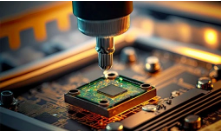- Ameya360 Component Supply Platform >
- Trade news >
- UMC Expects AI to Grow to $3 Billion Business
UMC Expects AI to Grow to $3 Billion Business
TAIPEI — United Microelectronics Corp. (UMC) expects artificial intelligence (AI) to contribute $3 billion to company revenue by 2021 as demand for edge computing and automotive devices takes off.
AI is forecast to be one of the fastest growing markets during the next few years as more companies adopt machine learning in everything from autonomous vehicles to cryptocurrency mining. The global AI market for semiconductors is projected to grow at a compound annual rate of 63 percent between 2016 and 2022, reaching $16 billion by 2022, according to research firm MarketsandMarkets.
UMC sees the driving forces behind the foundry business shifting from smartphones to AI and autonomous vehicles. While UMC declined to quantify how much its AI business is currently worth, the company said it is already doing AI-related work for edge computing devices and cars.
“In recent months, we’ve seen a lot of customers coming to us to talk about the automobile segment,” said UMC Senior Vice President of Marketing Steven Liu in an interview with EE Times. “Not just Europe. We also see a lot of requests from Japan and the U.S.” That demand is coming from both IDMs and fabless companies, he said.
In the automotive segment, UMC silicon goes into the power train, infotainment systems, ADAS and safety systems. UMC currently builds MCUs for infotainment and ADAS.
More business is coming to UMC through fabless companies such as Faraday Technology Corp., a company that’s part of the UMC ecosystem.
“Business for the design houses has been much stronger than I anticipated,” according to Liu. “The customer portfolio is different from before. A lot of the demand is from medium and small AI-related companies. We do see the momentum continuing.”
UMC’s revenue contribution from the automotive segment doubled between 2016 and 2017. Due to the stringent safety and quality requirements of the industry, UMC is taking a long-term view toward development work, much of which probably will not pan out until 2020 or even 2030, according to Liu. Power and ADAS are two areas where UMC sees strong demand.
Automobiles will soon play a different role, and quality, safety and the ability to communicate will become very important. UMC aims to focus on its automotive business by providing better quality and reliability. MCUs and ALRs are devices the company will aim for.
UMC expects power-related devices to show huge potential over the next 10years. “We have an advantage today, and we will definitely enhance our technology leadership,” according to Liu. UMC will announce partnerships with customers this year, he said.
Beyond the automotive business, UMC is aiming to provide devices for data sensing in edge computing such as MEMS sensors, audio codecs, control MCUs for robots and application processors for parallel computing.
UMC is also evaluating emerging memories such as MRAM.
“There is a chance we can be a leader here,” according to Liu. “At this moment, we are evaluating more than seven kinds of memories. Performance, cost and partnerships are among the factors UMC is considering.”
Moving in a New Direction
The company sees opportunity in AI as it moves in a new direction.
“Rather than chasing advanced nodes and following the giants, at this moment, we need to slow down before we pursue the advanced nodes,” Liu said. UMC’s focus will be on edge computing and end devices. The company sees potential in neuromorphic chips. They don’t necessarily need the most advanced process technology, according to Liu.
“UMC will have very good technology in sensors, which will be key elements for systems to retrieve data,” Liu said. Also microcontrollers. “MCUs will play a critical role for devices in IoT. That’s one reason why we will aim for strategic MCUs and SIM cards. Those are some of the key things that we see for AI.”
UMC offers a variety of microcontrollers and some of the most competitive bank card solutions, according to Liu.
UMC says its ecosystem is starting to change as demand for AI-related ASICs heats up. A lot of OEMs have their own design teams for software, algorithms and hardware. What’s different today is that the hardware also involves chip design. That has created a lot of demand, both direct and through design-service companies.
“Starting from the second half of 2016 through 2017, the design-service companies, especially in Taiwan, have seen their business go crazy,” Liu says.
Online messageinquiry

UMC Halts R&D Project with China Chipmaker
- Week of hot material
- Material in short supply seckilling
| model | brand | Quote |
|---|---|---|
| MC33074DR2G | onsemi | |
| CDZVT2R20B | ROHM Semiconductor | |
| TL431ACLPR | Texas Instruments | |
| RB751G-40T2R | ROHM Semiconductor | |
| BD71847AMWV-E2 | ROHM Semiconductor |
| model | brand | To snap up |
|---|---|---|
| TPS63050YFFR | Texas Instruments | |
| STM32F429IGT6 | STMicroelectronics | |
| IPZ40N04S5L4R8ATMA1 | Infineon Technologies | |
| ESR03EZPJ151 | ROHM Semiconductor | |
| BP3621 | ROHM Semiconductor | |
| BU33JA2MNVX-CTL | ROHM Semiconductor |
- Week of ranking
- Month ranking
Qr code of ameya360 official account
Identify TWO-DIMENSIONAL code, you can pay attention to


Please enter the verification code in the image below:
























